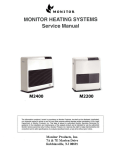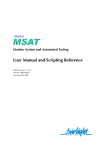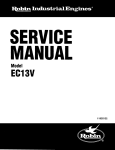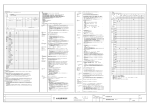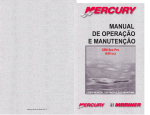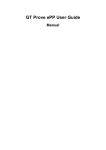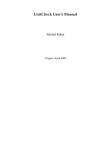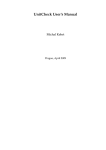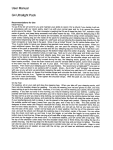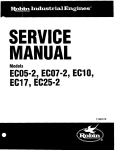Download Robin America EY44-2 Service manual
Transcript
SERVICE MANUAL Models EC06, EC08 1193s1 20 ROBIN AMERICA, INC. ROBIN TO WISCONSIN ROBIN ENGINE MODEL CROSS REFERENCE LIST WISCONSIN ROBIN ROBIN 0 SIDE VALVE W 1-080 W1-145 W1-145V W1-185 W1-185V W1-230 W 1-280 W 1-340 W 1-390 Wl-45OV EY21W EY44W EY18-3W EY25W EY27W EY08 EY15 EY 15V EY20 EY2OV EY23 EY28 EY3 5 EY40 EY45V EY2 1 EY44 EY 18-3 EY25 EY27 OVERHEAD VALVE WO1-115 wo1-120 WO1-150 WO1-170 wo1-210 WOl-250 WO 1-300 WO1-300V WO1-340 WO 1-340V WO 1-43 OV EH11 EH12 EH15 EH17 EH21 EH25 EH30 EH30V EH34 EH34V EH43V 0 TWO CYCLE WT1-125V EC13V DIESEL DY23 DY27 DY30 DY35 DY4 1 WRD 1-230 WRD 1-270 -1-300 WRD1-350 WRD1-410 0 CONTENTS Section 1 . Page Title 2 . PERFORMANCE 4 . 1 ................................................ 2 Maximum Output . . . . . . . . : . . . . . . . . . . . . . . . . . . . . . . . . . . . . . . . . . Rated Continuous Output . . . . . . . . . . . . . . . . . . . . . . . . . . . . . . . . . . ; . Maximum Torque and FuelConsumption Ratio a t Maximum Output . . . . . . . . 2-1 2-2 2-3 3. .............................................. SPECIFICATIONS FEATURES .................................................... DISASSEMBLY and REASSEMBLY 4-1 4-2 4-3 4-4 . .................................. Preparations and Suggestions .................................. Special Tools . . . . . . . . . . . . . . . . . . . . . . . . . . . . . . . . . . . . . . . . . . . . . Disassembly Procedure ...................................... Reassembly Procedure ....................................... 5. CONTACTBREAKERADJUSTINGPROCEDURE(EC06) 6. CARBURETORADJUSTMENT 7. GOVERNORADJUSTMENT . 8 TROUBLE-SHOOTING 8-1 8-2 8-3 8-4 8-5 8-6 8-7 9. . 10 5 5 5 6 9 .................. 13 ..................................... 14 15 ........................................... 16 Starting Trouble . . . . . . . . . . . . . . . . . . . . . . . . . . . . . . . . . . . . . . . . . . . Idling Improper . . . . . . . . . . . . . . . . . . . . . . . . . . . . . . . . . . . . . . . . . . . OverheatingandEngine Knocking . . . . . . . . . . . . . . . . . . . . . . . . . . . . . . . Power Drop : . . . . . . . . . . . . . . . . . . . . . . . . . . . . . . . . . . . . . . . . . . . . . Excessive FuelConsumption . . . . . . . . . . . . . . . . . . . . . . . . . . . . . . . . . . . Hunt.ing Other Troubles . . . . . . . . . . . . . . . . . . . . . . . . . . . . . . . . . . . . . . . . . . . . . . ................................................ 16 19 19 19 20 20 20 ...................................... 21 EngineStandard Correction Table . . . . . . . . . . . . . . . . . . . . . . . . . . . . . . . Table of Tightening Torque . . . . . . . . . . . . . . . . . . . . . . . . . . . . . . . . . . . 22 24 ..................................... 25 MAINTENANCE and STORING 10-1 10-2 10-3 10-4 10-5 4 ....................................... CHECKS and CORRECTIONS 9-1 9-2 2 2 2 Daily ChecksandMaintenance . . . . . . . . . . . . . . . . . . . . . . . . . . . . . . . . . . Every 50 HoursChecksandMaintenance :. . . . . . . . . . . . . . . . . . . . . . . . . Every 150 HoursChecksandMaintenance .......................... Yearly Checks and Maintenance ................................ Preparation for Long Abeyance . . . . . . . . . . . . . . . . . . . . . . . . . . . . . . . . . 25 25 25 25 25 Fuel Tank Cap Recoil Starter ECOGD n Spark Plug Muffler Cover overnor Lever Engine Base (optional) Governor Chamber (Engine base is opti onal.) ECOGB ECOGD Model ECOGB ECOID ECO~B Air-Cooled, 2-Cycle, Vertical, Piston Valve Type, Single Cylinder Gasoline Engine Bore x Stroke lacement Piston 44mmx40mm cc 78.5 Continuous Rated Output (HP/rpm) I I 50 mm x 40 mm . .60.8 cc I 1.6/3600,1.9/4500 11.6/1440, 1.9/1800 Maximum Output (HP/rpm) I 2.5/5000 . . I 2.5/2000 1 1 2.2/4500 3.3/5500 2.2/1800 3-3/2200 ~~ Maximum Torque (kg-m/rpm) I 0.38/3700 Direction of Rotation . .' . 0.95/1480. 0.51/3600 Counterclockwise as viewed from P.T.O. Shaft Side ~ ~~ Fuel-lubricant Mixture Type Lubrication ~~ I Lubricant Carburetor' . I 2-Cycle Engine Oil . . _- Float Type Fuel . . Gasoline-lubricant Mixture (20- 25: 1) ~ ~~~ 390 a t RatedContinuous Output380 Fuel Consumption Ratio (gr/HP-h) Fuel Feed 1.5 1.27li440 at RatedContinuous Output Gravity Type Fuel Tank Capacity iitres L . ~ Flywheel Magneto Type (Contactless Magneto Type is also available.) Ignition System .- I 'Starting System Starter Speed Governor NGKB7HS Recoil Centrifugal Flyweight Type Speed Reduction System Reduction Chamber Oil Contactless Magneto Type I NGKB6HS Spark Plug ~~ . . - 1/2.5 Reduction Gear - - SAE #30 - .Air Cleaner . 1/2.5 Reduction - SAE#30. Semi-wet Type Dry Weight I Length 256 mm 285 mm 256 mm 285 mm Width 307 mm 307 mm . 307 mm 307 mm' Height 287 mm 287 mm 287 mm 287 mrn " Dimensions 2. PERFORMANCE 0 2-1 MAXIMUM OUTPUT 1 Maximum output refers to the standard power produced by a sufficiently run-in engine with the carburetor throttle valve fully open. A new engine cannot always deliver maximum output power because it has not been well run in. 2-2 RATEDCONTINUOUSOUTPUT ri/ The term refers t o a continuous output most ideal to engine life and fuel consumption under governorcontrol. In combining your ROBIN engine with a load, design your driving system so that the engine may be continuously used at a load level not exceeding the rated continuous output. 2-3 MAXIMUM TORQUE and FUEL CONSUMPTION RATIO a t MAXIMUM OUTPUT Maximum torque refers to the driving torque of the drive shaft when the engine is driving the external load at maximum output. The term fuel consumption ratio at maximum output refers to the fuel consumption ratio when the engine is operation at the maximum output. PERFORMANCE CURVE MODEL ECOGD/B ( HP 1 for B type I w 2 P + 6 (1 600) (1 200) W -- Revolution -2- r.p.m. (2000) PERFORMANCE CURVE MODEL EC08D/B . ( HP ) for B type kg-m ( 1.25) W (0.75) gr/H P-h (1600) (1 200) -* (2000) r.p.m. Revolution -3- 3. FEATURES 1. Compact, lightweight, high-powered enginewith reliable operation alsoin the low speed range 2. Extremely simple in construction, trouble-free, and veryeasy to use (EC06) 3 . Quiet running engine using a lined aluminium cylinder 4. Equipped withT.C.I. (Transistor Circuit Ignition) 5 . So durable that theengine can stand hours of tough work. Needle bearings are used for the crank pins and piston bearings t o enable the engine t o withstand highspeed operation underheavy load. 6. The carburetor works at inclinations of up t o aboaut 30" so that the engine can operate until the fuel overflows from its air vent. 7 . The recoil starter permitseasy starting. 8. Useful in a wide rangeof applications A direct-coupled, reduction type engine, and other types that differ from the standard models in drive shaft dimensions and shape arealso available. 9. The all-speed governor operates at any engine speed. The desired rpm. can be obtained by simply moving the control lever, and it remains constant even if the load changes. IO. Resistant to vibration (EC08) Manufacturers of rammers and plates (machines for compacting earth by vibration) around the world are using theseROBIN engines. -4- 4. DISASSEMBLY and REASSEMBLY 4-1 PRE-PARATIONS and SUGGESTIONS .Disassembly . . . -1) In"disassembling, remember the location of each part so that the disassembled partsEcan be reassembled . . . in the right way. Attachtags to those parts which might be mistaken for others. 2) Carefully handle the gaskets because they can easily break. 3) Temporarily fasten disassembled parts in their original positionsto prevent them from missing and wrong reassembly. 4) Carefully handle disassembled parts and clean them with kerosene. 5 ) Use thecorrect tools in the correct way. 6) Items necessary for disassembly and reassembly . . Disassembly c. tools d. Kerosene or gasoline 'Work a. bench b. Kerosene pan e. sandpaper, spatula,wastecloth . . 7) Be sure to discharge the'fuel and oil before disassembling. , . I 1 . 1 .Reassembly m 1) Use new packing and gaskets in reassembling the engine. 2) Clean the parts with fresh gasoline, and blow them dry with compressed air before reassembling. 3) Apply 2-cycle oil to the rotary andsliding parts. 4) Keep the.parts free of dust during reassembly. Tighten.the bolts, nuts, andscrews.with the specified torques. 5) Each'time a setof main parts is installed, manually'turn it and check for smoothness andnoise.' 6) After reassembling the engine, turn it manually and check for abnormalities and looseness. . 4-2 SPECIALTOOLS . . . . % " .. Flywheel Pulley Fig. 1 . . I 4-3-9 CONTACT BREAKER,CAPACITOR, IGNITION COIL 4-3 DISASSEMBLY PROCEDURE 4-3-1 DISCHARGINGFUEL [Point Type for EC06 (See Fig. Discharge the fuel from thefuel tank. 4-3-2FUEL TANK 1) Disconnect the pipe connecting the fuel filter to the carburetor at the carburetor end. 2) Remove the fuel tank from the cylinder and fan cover. 4-3-3 STOP BUTTON CORD 1) Remove the screws that fasten the capacitor and point cover together, and remove the point cover from the crankcase. 2) Remove the socket type terminal and mounting screws,remove thecapacitor,contactbreaker, and ignition coil from the crankcase in thisorder. Note: Exercisecareinremovingthe from the crankcase. Disconnect the cord from the socketterminal. 3A.)] grommet 4-3-4FAN COVER Remove the bolts and then the with the stop button. fan cover together Ignition Coil Note: The rubber baffle comes off simultaneously. 4-3-5 CYLINDERCOVER Remove the bolts and then the cylindercover. 4-3-6 STARTER PULLEY Remove the bolts and then the starter the flywheel. pulley from Point Cover Breaker 4-3-7 MAGNETO and FLYWHEEL Remove the nut and take the flywheel from the front end of the crankshaftusing the flywheel puller. (See Fig. 2.) Fig. 2 4-3-8 WOODRUFF KEY Hold a screwdriver with its flat part on the woodruff key, and lightly strike the screwdriver to remove the key with a mallet. -6- Fig. 3A n \ / [ T.C. I. (Transistor Control Ignition) magneto] 1) Features The T.C.I. magneto completely solves the problems with the conventional point type magneto, that is, stains, burns, rusting during long storage, ignition timing deviation due to mechanical wear, etc. 2) Construction The components of the magneto assembly are as shown in Fig. 3B. The main parts of the magneto are explained. Flywheel Complete ./ T.C.I. Unit FLYWHEEL COMPLETE The FLYWHEEL COMPLETE haspermanent-magnets so that the rotation of these magnets generates an AC electromotive force in the primary coil of the generating assembly. GENERATING ASSEMBLY The GENERATING ASSEMBLY consists of the primary coil and secondary coil. The rotation of the FLYWHEEL COMPLETE generates a voltage in the primary coil and feeds a current. At the same time a high voltage is induced in the secondary coil. Thishigh voltage causes the spark plug to spark. T.C.I. UNIT The T.C.I. UNIT consists maily of an SCR and other semi-conductor parts. Itsenses the primary current waveform generated in the GENERATING ASSEMBLY, and switches the transistor to cut off the primary coil current. This abrupt currentchange causes a high voltage to be induced in the secondary coil. Generating Assembly ~ Fig. 3B - 3) Wiring diagram r T.C.I. Unit -7- Prim r Wir Spark Plug * Assembly Fig. 3C 4-3- 10 CARBURETOR, GOVERNOR LEVER 4-3 - 13 REDUCTION GEAR (TypeB only) 1)Remove thenutandthenthecarburetorfrom the cylinder. 2) Loosen the nut, and remove the governor lever from the governor shaft. 3) Remove the governorspring from the governor lever. 1) Remove the drain plug from the reductionchamber to discharge the oil. 2) Remove the reduction chamber cover from the engine. 3) Remove the nuts, and pull the reduction pinion out from the crankshaft. (See Fig. 6.) 4) Remove the woodruff key. c Carburetor eduction Chamber Reduction Cover Governor Lever 'Drain %@" % Reduction Pinion Plug Woodruff Key L n Fig. 6 Fig. 4 \ 4-3-1 1 SPARK PLUG 4-3-14CYLINDER Remove the spark plug using a box wrench. 4-3- 12 MUFFLER (MUFFLER COVER) Remove the nuts, and then the muffler from the cylinder. (See Fig. 5 . ) Note: Keep the muffler cover on. Nut Remove the nuts, and carefully lift the cylinder off, exercising care not to damage the contact surfaces of the piston and cylinder.(See Fig. 7.) Note: Hold the piston when the cylinder is lifted to a certainheight from the crankcase, and raise the cylinder off the piston. Damage to them can be prevented this way. p/ Cylinder Muffler Cover rankcase fig. 5 Fig. 7 -8- 4-3- 15 DIVIDING CRANKCASE 4-4 REASSEMBLY PROCEDURE Remove the bolts, and carefully strike the crankcase with a mallet t o part it. (See Fig.8.) Clean the divided crankcase with gasoline, and apply engine oil to the bearing, and grease to the oil seal lips. 4-4-1 CRANKSHAFT COMPLETE and PISTON Note: Be careful not to damage the crankcase joint. Apply engine oilto theneedle bearing, and fitit onto the small end of the connecting rod. With the mark M on the piston head on the flywheel (magneto) side fit the piston head on the piston. Apply engine oil t o the piston, and lightly strike the pin into the piston with a mallet (until the pin is poisitoned inward of the clip grooves). Then fit two clips into the clip grooves. (See Fig. 10 .) Note: Be careful n o t t odamage the piston pin hole in the piston. Be sure to use new clips. The mark M must be in the direction of the front end of the crankshaft. \ Rear Crankcase I Crankshaft Fro"; Crankcase Fig. 8 4-3- 16 PISTON, PISTON PIN, NEEDLE BEARING, and CLIPS (See Fig. 9.) Remove the clips. With a iron rod 10 t o 1 1 mm in diameter on the piston pin, lightly strike it with a plastic Hammer t o remove the piston pin. Pull out the iron rod, andremove the piston andneedle bearing. Fig. -10 . I 4-4-2 INSERTINGCRANKSHAFTINTO CRANKCASE Note: Be careful not to damage the.piston pin hole in the piston. Place therear half of the crankcase on thework bench securely, and insert the crankshaft into the crankcase bearing by hand. Note: See that the front and rear halveso f the crankcase can be reassembled properly. 4-4-3 CRANKCASE REASSEMBLY (See Fig. 1 1.) Wipe the joint surfaces of the front and rear halves of the crankcase until oil is completelyremoved from them, apply a sealant to them, and with the dowels in line with their matching holes, reassemble the crankcase. Note: Exercisegood care not todamage the governor sleeve, yoke assembly, and oil seals. Keep the joint surfaces o f the front and rear halveso f the crankcase parallel to each other in pressing them together into the originalassembly. -9- I Crankshaft Rear Crankcase \ Governor Yo1 ke 4-4-7 SPARK PLUG Tighten the sparkplug into the cylinder. Note: Tightening torque. . . . . . . 275 +25 kg-crn 4-4-8 GOVERNOR LEVER Tighten the governor leverto thegovernor shaft with the nut. (For the adjusting procedure, refer to the section on governor adjustments.) 4-4-9 GOVERNORSPRING I E Governors' Front Crankcase I ' I Hook the governor spring to the governor lever and governor. (See Fig. 13.) Note: Be careful of the hooking positions. Fig. 1 1 4-4-4 CRANKCASE Tighten the bolts with spring washers and plain washers. Note: Tightening torque . . . . . 1 10 f 20 kg-cm . 4-4-5 CYLINDER REASSEMBLY (See Fig. 12.) Replace the old cylinder gasket with a new one, apply oil to thecylinder and piston, make sure that the piston rings and cylinder are positionedcorrectly, and install thecylinder. n / Governor Lever Note: Be careful not to let the gasketslide out of place. Governor Spring (attached to bottom) Fig. 13 Cylinder 4-4- 10 CARBURETOR Replace the old gasket with a new one, and install the carburetor. Note: Tightening torque . . . . . . . . 80 2 IO kg-cm 4-4- 11 MUFFLER (MUFFLER COVER) Replace the old gasket with a new one, and tighten the muffler to thecylinder. Note: Tightening torque . . . . . . . . 80 f IO kg-cm 4-4- 12 WOODRUFF KEY Drive the woodruff key into the keyway in the crankshaft using a mallet. Fig. 12 Note: Drive it parallel to the shaft axis. 4-4-6CYLINDER TIGHTENING Tighten the nuts with springwashers and plain washers. Note: Tigtening torque. . . . . . . . 1 10 k Tighten all the four nuts evenly. IO kg-crn 4-4- 13 IGNITION COIL TEMPORARY TIGHTENING With the high-tension cord (to be connected to the spark plug) up, temporarily tighten the ignitioncoil. - 10 - n 4-4- 17 FLYWHEEL (MAGNETO)' 4-4- 14 CONTACT BREAKER (POINT) CAPACITOR (EC06) Installthecontact breakerby inserting'itsshaftinto the matching hole in the rcrankcase. Pass the cord under the capacitor into the cord hole in the crankcase. Temporarily tighten the capacitor. 4-4- 15 IGNITION TIMING CHECK (EC06) Install the flywheel on the crankshaft by tightening the nut'withplain and spring washers. Note: Completely remove oil from the tapered portion. Tightening torque . . . . . . . 400 k 20 kg-cm 4-4- 18 IGNITION COIL Adjust the air gap with a searcher, and tighten the ignition coil with plain and spring washers. (See Fig. 15.) Temporarily install the flywheel, and check and adjust the ignition timing. mm (For ignition timing adjustment, refer to the section Note: Air gap. . . . . .0.5 on contact breaker adjusting procedure.) Tightening torque .......... 50 f5kg-cm foe. Note: Ignition timing 4-4- 16POINT ............... 23" k2' COVER (EC06) , ,' Remove the flywheel, fit the point-to-capacitor lead into the crankcase groove, and install the.point cover. (See Fig. 14.) Tighten the temporarily tightened capacitor securely. Note: Tightening torque . . . . . . . . . 25 f 2 kg-cm Lead Wiring Method Fig. 15 4-4-,19STARTER Crankcase Groove II -./ I / Tighten the starter pulley to the flywheel with the bolt. (Use plain and spring washers.) Note: Tightening torque . . . . . . . . 90 f IO kg-cm / 4-4-20 FANCOVER,STOP BUTTON, GROMMET (See Figs. 16 and 17.) Capacitor Lead Primary Wire Turn primarywire onceand pull i t in direction A. w I PULLEY Install the stop button with lockwasher on the fan cover.Insert the high-tensioncord into the grommet, and install baffle rubber on the fan cover. Fit the grommet into thefan cover groove and, with the tip of therubber baffle attheround boss in the crankcase,fasten the fan cover on the crankcase with the bolt. I Capacitor lead is above primary wire here. Fig. 14 Note: Be careful not to pinch the stop button cord between the crankcase and fan cover. Also exercise care not to drop the rubber baffle during fan cover reassembly. Tightening torque . . . . . . . . 90 2 10 kg-cm . -11 - L 4-4-21 CYLINDERCOVER Insert the cylinder cover tips into thematching slots in the crankcase, and tighten the cylinder cover on the cylinder. (See Fig. 18.) Note: Insert the cylinder cover tips in to the slots on both sides. Tightening torque . . . . . . . . 80 f 10 kg-cm Cylinder Cover Installing Method (Position in Model D l Fig. 16 Buffle Rubber installing Method Whichever type, D or B, your engine is, be careful of the punched marks on the crankcase in reassembing. Wider end up Crankcase Punched Mark (case) Flat surface inside Fig. 18 Baffle Rubber 4-4-22 FUEL TANK Type D Note: Install right of the magneto. Insertthe fuelpipe intothecarburetor, clamp it, and mount the fuel tank on the cylinder fan cover. Note: Tightening torque . . . . . . . . 90 f 10 kg-cm Wider end up Punched Mark (case) Flat surface inside Baffle Rubber , Type .Note: Install left of the magneto. fig. 17 - 12 - f7 , ’ 5. CONTACT BREAKER ADJUSTING PROCEDURE (EC06) 1) Remove the fan cover. 2) Remove the starter pulley. 3) Remove the flywheel. 4) Loosen the capacitor screws. 5 ) Remove the point cover. 6) Remove carbon and other foreign particles from the point, polish-the contact surface with sandpaper No.400 or equivalent, and wipe dirt off with a cloth. 7) Temporarily fasten the flywheel, bring the mark F in line with the matching mark on the crank case, and remove the flywheel, exercising care not to turn it. 8) Now, in this state, adjust the contact breaker as shown below. (See Fig. 19.) Mark Fig. 19 Note: I f the points are open in the sate illustrated above, ignition timing goes wrong to a serious extent. Be careful not to move the points especially when tigtenirig the breakermount screw. Ignition timing . . . . . . . . . . . . . . . . . . . . .I.. . . . . . . 23" *2'' a ) . Loosen the breaker mounting screw. b) Push the breaker in the arrow direction to a position just before the points begin to open (using a timing tester, for example), and tighten'the breaker mounting screw. c) After the point adjustment,install the point cover, capacitor, magneto, and fan cover in this order. - 13 - 6. CARBURETORADJUSTMENT n The carburetor is carefuuly adjusted in the factory before shipment.Never attempt to adjust it except when necessary. 1) Idling Adjustment (See Fig. 20.) Move the governorlever to thelowest speedposition (so that the carburetor throttle valve fully closes), and check that the engine idles quiet and smooth. This is the ideal idling condition. Normally, the engine is set to anidling speed of 1600 k 100 rpm, for which thefollowing two methods may be used. a) Low-speed stopper screw Engine speed increases if the low-speed stopper screw on the carburetor is turned clockwise, or decreases if it is turned counterclockwise. b) Pilot screw (Do not turn it except when necessary.) When thepilot screw is turned clockwise, the fuel-air mixture decreases and the engine slows down. If the pilotscrew is turned counterclockwise, the fuel-air mixture increases to raise engine speed. The normal positionof the pilot screw is one turn anda quarter back from the clockwise extremity. Fig. 20 2) Maximum Speed Adjustment (See Fig. 2 1.) The standard maximum speed is 5000 rpm for EC06, or 5500 rpm for EC08. Move the governor lever tothe highest speed position,adjustthecrankshaftrpmto 5000 (EC06)or 5500 (EC08)withthe high-speed stopper bolt, and lock the bolt with the nut. Governor Lever Low Speed Fig. 21 - 14 - I 7. GOVERNOR ADJUSTMENT Fully open the carburetor butterfly valve, fasten the governor lever, turn the governor shaft fully counterclockwise, and fasten the governor lever on the governor shaft with the nut.(See Figs. 22 and,23.) Fig. 22 Governor Rod Governor Rod Spri Throttle Lever Carburetor Governor Lever Crankshaft eed Stopper Bolt Governor Sleev Control Lever Fig. 23 - 15 - 8. TROUBLE-SHOOTING The following three conditions must be satisfiedfor satisfactory engine start: 1) The cylinder filled with a proper fuel-air mixture 2) An appropriate compression in the cylinder 3) Good spark at correct time to ignite mixture The engine cannot be started unless these three conditions are met. There are also other factors which make engine start difficult, e.g., a heavy load on the engine when it is about to start at low speed, and a high back pressure due to a long exhaust pipe,just to say a few, The most common causes of engine troubles aregiven below: 8-1 STARTING TROUBLE Trouble Cause I Remedy Preventive hints I No or little spark Spark plug defective (1) If spark plug is dirty, clean it well with gasoline (1) Use a spark plug of the specified heat value. Do not use or polish it with sand-paper. Remove foreign low-quality oil. Clean the air matter if any. cleaner to prevent dust from (2) Adjust spark gap to 0.6 0.7 mm. entering. (3) If spark plug hasfaulty instulation due to (2) Be carefid not to strike the breakage, replay it with anew one. center pole or forcibly twist it in adjusting spark gap. Otherwise, insulation breaks down. - High-tension cable defective If defective, replace the cable and ignition coil together. Contact breaker defective (1) If points are rough, polish them with sand- paper No. 400. (2) If point gap is wrong, loosen contact mount screw, and adjust it to 0.35 ? 0.05 mm. Also adjust ignition timing if possible. (3) If ignition timing is wrong, adjust it to 23' f 2' before top dead center. (4) If breaker has faulty insulation, replace the breaker with a new one. (5) If capacitor is defective, replace it with a new one. - 16 - rrouble Vo or little Magneto defective ;park (1) If coil is broken or its insulation defective, replace magneto with anew one. (2) If magnetism has decreased, have it remagnetized at magneto manufacturer's or replace magneto.with a new one. ~~ No or little compression No fuel feed ~ ~~ Electrical system defective (1) If stop button is defective (grounded), repair or replace it. (2) If primary wire is grounded to the engine body, insulate it with tape. Fuel leaks from gaskets or other (1) If head gasket is defective, replace it with a new one. (2) If spark plug is loose, retighten it securely. (3) If spark plugis defective, replace it with a new one. Piston defective (1) If piston is worn, replace it with a new one. (2) If piston rings are worn, replace them with new ones. [ l ) Keep air cleaner clean. :2) Do not use lowquality oil. (3) Change oil periodically. Fuel tank defective (1) Clean tank outlet if clogged up. (2) Clean fuel strainer if clogged up. (3) If wrong fuel is used or if water is in fuel tank, change fuel. (4) If air is trapped in fuel pipe, discharge air. (1) Pour fuel into the fuel tank through filter. (2) Use gasoline-oil (25 to 1) mixture. Carburetor defective (1) Clean carburetor if clogged up. (2) Replace carburetor with anew one if defective. Clean jets and orifices if clogged up. Excessive fuel suction Excessive resistance to starting Preventive hints Remedy Cause ' (1) Fully open choke, half open throttle valve, and start engine. (2j Remove crankcase drain plug, close fuel cock, actuate starter afew times to discharge excess fuel. Carburetor defective (1) If carburetor overflows, checkneedle valve seat for wear, and replace if necessary. Excessive load (1j Adjust power transmission belt tension if too high. (2) If it is still hard to start, install a clutch. Piston or connecting rod sticky (1) If piston is sticky, replace it with a new one. (2) If connecting rod is sticky at large or small end, replace it with anew one. - 17 - (1) Never close choke if engine is warm. (2) Be sure to idle engine for some time before stoppingit. This'not only makes next . starting easy but helps extend engine life. (3) Completely clean air cleaner because a clogged up air cleaner thickness fuel. (1) Do not use lowquality oil. (2) Use-fuel of correct gasolineoil ratio. w Spark plugs won't spark. OK Wire connector loose Connect connectorsecurely. Wire damaged Replace damaged parts. Not securely mounted on engine Mount it on engine securely. L - ~ - i OK Conduct continuity test on T.C.I. unit faulty T.C.I.unit. [See 5 . I).] r"\ \ I Conduct continuity test on coil. [See 5.2).] Generating assembly faulty 1) Continuity test on T.C.I. unit Conduct this testusing the T.C.I. unitchecker (Part No.106 79902 00). Select either AC or DC. (Battery is installed inside.) Connectthe unit'sprimary lead (black for type D, or yellow for type B) to jack E (black) andtheunit casing (orthe crankcase if the unit is mounted on the engine) to jack C (red) with the supplied cable. Turn the select dial to the position correspoilding to the,engine type. Keepthecheckswitch in the ON position, and wait until the pilot lamp(LED) lights. - la Robin Checker for T.C.I. Unit Spark Gap Check Window wer Select Switch Check Switch Select Dial Fig. 24 - - e) When the pilot lamp turns on, return the check switch to the OFF position. The T.C.I. unit is normal if a spark is observedat that instant. If the T.C.I. unitchecker is not available, use a circuit tester as described below. "i) Connect the positive (+) terminal of the tester to theprimary lead. Connect the negative (-) terminal of the testerto the unitcasing. Resistance: 80 to 150 ohms(Tester range x 1 ohm) *ii) Connect the negative (-) terminal of the tester to the p$mary lead. Connect the positive (+) terminal of the tester to the unitcasing. Resistance: 7 t o 10 k oiims (Tester range x 100 ohms) If the T.C.I. unit is found not normal by the above test, replace the unit. 2) Continuity test on generating assembly Measure the resistance with a circuit tester. a)Resistancebetweenprimarylead andcore: 1.1 to 1.5 ohms b) Resistance between secondary lead and core: 10 to 13 k ohms If the generating assembly is found not normal by theabove test, replace the assembly. Note: A circuit tester is not so accurate that the resistance values measured by the tester may vary depending on the type of tester, or the conditionof battery, or the skill of operator. ' 0 8-2 IDLING IMPROPER 1) If the carburetor'spilot screw is notcorrectlyadjusted,adjustit.(Refer adjustments.) 2) Any of starting trouble causes leads t o improper idling. to the section oncarburetor 8-3 OVERHEATING and ENGINE KNOCKING * 1 ) I f ignition timing is advanced, adjust it to 23" 2". (EC06) 2) I f the cmbustion chamber has excessive carbon deposits, clean it. 3) If a spark plug of a heat value too low is used, use one of the specified heat value. Example: NGK B6HS for EC06, NGK B7HS for EC08 4) If the gasoline air-mixture is too lean, clean the jets and orifices of the carburetor. Also clean the aircleaner. 5) I f overload is the case, reduce it to normal level or below. ' 8-4 POWER DROP' 1 ) Replace the cylinder, piston, and/or piston rings if worn. 2) If the carburetor is faulty, adjust orclean it. 3) If the spark plug is faulty (dirty, leaky, or notproperly insulated), clean or replace it. 4) Retighten the cylinderif gas leaks. 5) Replace or adjust if the magneto or contact breaker is faulty. 6) Clean the air cleaner if clogged up. 7) Replace the crankshaft oil seals if compressed gas leaks due to seal wear. -19- 8-5 EXCESSIVE FUELCONSUMPTION 1) 2) 3) 4) If the gasoline-air mixture fuel is too rich, clean the carburetor jetsand orifices. Replace the carburetor if its throttle shaft is worn. Retighten or replace parts if fuel leaks. Take the steps against power drop described in Paragraph 8-4above because excessive fuel consumption also results from power drop. 8 - 6 HUNTING 1) If the governor lever, governor shaft, or governor spring is not properly set or adjusted, readjust or correct it. 2) If the mixture fuel is too lean, clean the carburetor. 3) If the carburetor pilotscrew is the cause, readjust it. 4) If the governor spring is worn, replace it. 5) If the governor sleeve does not work properly, correct it. 6) Replace the flyweight or governor sleeve if worn. 7) If the governor shaft does not work properly, correct it. 8-7 OTHERTROUBLES 1) Carburetor overflow If the fuel overflows the carburetor to the air cleaner, or collects excessively in the crankcase during stoppage, either the floatvalve or float is faulty. Replace or correct the faultyone. 2) If the engine abruptlystops with an abnormalnoise,it is dueto a stickypiston,crankshaft, or connecting rod. Adjust or replace the faulty parts. 3) If any abnormal noise is heard during engine operation, be sure to stop the engine immediately. Do not start the engine again until the cause is determined. If you cannot find the cause, contact your nearest dealer or service shop, and observe their advice. - 20 - f"\/ .. ._ . .. . .. . . . ... . . ... . . . . . . " . , , . ,. . , I 8 % I . . I .j , . ... . .. . . - , . . . - . , '9. CHECKS and CORRECTIONS ~- - :' 0 . . -. ' " . I . . . . After disassembiing and cleaning the'engine, check and adjust the parts according to the Standard Correction . ;Table, .-whichprovides importantinformationto bereferred to in adjusting or repairing the engine. Be . ;.fWiliar-with the table and conform to the.standards specifiedin servicing the engine. The terms used in the table aredefined as follows: . 1) - Correction . Repair, adjustment,or replacement of any engine part .2) Correctionlimit The limit of wear, damage, or function degradation beyond which an engine part can hardly serve its purpose unless if is corrected. . 3) Standard dimensions Design dimensions less tolerance . ' : . . -21 - 9-1 ENGINE STANDARD CORRECTION TABLE I Measuring/Correcting Point Clearance between piston and cylinder Bore T Model Standard Dimensions EC06 Perpendicular t o pin 0.07-0.1 06L Pin direction 0.09-0.146L EC08 Perpendicular to pin 0.04-0.076 L Pin direction 0.07-0.1 26L EC06 tO.016 Correction Limit Instrument Correction 0.18L Calculate from parts measurements. +0.08 Average of maximum and minimum inside diameters Cylinder gauge Replace -0.05 Average of maximum and minimum outside diameters Micrometer Replace 0.1 5L Measure after removing carbon. Searcher Replace 0 44@ EC08 / Measuring Replace M.016 0 5w Piston outside dia. Piston ring side clearance EC06 43.930 EC08 49.960 EC06 First ring 0.05-0.09L Second ring 0.04-0.08L EC08 First ring 0.06-0.1OL Second ring 0.03-0.07L Piston ring groove width EC06, EC08 1.8 4-0.13 Measure maximum groove width. Block gauge Replace Piston ring width E m , EC08 1.8 -0.10 Measure minimum Lvidrh. Micrometer Replace Ring gap EC06, EC08 0.1-0.3 1.o Ring in contact with cylinder wall Searcher Replace Clearance between piston and piston pin EC06, EC08 0.005T-0.014L 0.03L Calculate from parts measurements Piston pin hole EC06, EC08 M.03 Measure maximum inside diameter Piston pin outside diameter EC06, EC08 -0.017 ~~ - 22 - Replace Cylinder gauge Replace Micrometer Replace ~~ Measure minimum outside diameter. I MeasuringlCorrecting Point Model Standard Dimensions Correction Limit 0.1 -0.6L 0.8 L Measure after reassembly Searcher Measuring instrument Correction Connecting r o d large end side clearance EC06, EC08 Crankshaft deviation EC06. EC08 0.05 or less 0.1 in reassembled state, support both ends of crankshaft, and measure it about 7.5 mm from crank web. Dial gauge Crankshaft axial play EC06, EC08 0.1 5-0.69 0.1 Measure after reassembly. Dial gauge Main bearing outside diameter EC06, EC08 0.050T-0.01.4T 0 Calculate from parts measurements Housing inside diameter EC06, EC08 Front case 47@ Rear case 420 -0.04 Housing Cylinder gauge Replace Bearing outside diameter EC06, EC08 Front case 470 Rear case 420 -0.016 Measure bearing outside diameter Micrometer Replace Main bearing outside diameter clearance EC06, EC08 Front 0.013T-0.006L Rear 0.01 T-0.009L 0.01 2 L Calculate from parts measurements. Bearing inside diameter EC06, EC08 20@ M.005 Measure bearing inside diameter. Cylinder gauge Replace Crankshaft outside diameter EC06, EC08 -0.02 Measure crankshaft outside diameter Micrometer Replace Connecting r o d small end inside diameter EC06, EC08 +0.026 Cylinder gauge Replace ~ Replace Replace Replace 0.01 5L ~ Ignition timing EC06 23' f 2O Timing tester Adjust Point gap EC06 0.35 * 0.05 Searcher Adjust Air gap EC06 0.5 Searcher Adjust Searcher Adjust 0 -0.1 0.6-0.7 - 23 - 9 - 2 TABLE of TIGHTENING TORQUE Parts to tighten No. Tightening torque Screw diameter Remarks kgcm 1 Cylinder Cover, Muffler Cover 80*10 M6 5T 2 Fan Cover, Tank Support Plate, Starter, Starter Pulley 90k10 M6 5T 3 Crankcase 110 -+20 M6 7T 4 Air Cleaner 50 +5 M5 5T 5 Reduction Cover 110+20 M6 7T 6 Muffler 80+10 7 Cylinder 110+10 M6 7T Nut 8 Carburetor 80 + l o M6 4T Nut 9 Governor Yoke 18 *2 M3 4T 10 Governor Plate 5025 M5 4T 11 Ignition coil 50 *5 M5 4T 12 Contact Breaker, Condensor Point Cover 25 +2 M4 4T 13 Reduction Pinion 340 220 M I 2 4T 14 Spark Plug 275 *25 MI4 15 Magneto Flywheel 400 + 20 M106T 16 Governor Lever 80*10 M6 4T 17 Stop Button 40 +5 M4 4T 18 Rear Half of Crankcase . M6 Nut M6 (Stand) - Note: Be careful not to apply screw lock more than necessary. - 24 - Type B only Apply screw lock (FT15 or equivalent) and install (as in the case of EC05, EC07) Nut, Type B only Apply screw lock (FT15 or equivalent) and install (as in the case of EC05, EC07) 10. MAINTENANCE and STORING 0 . . , The following maintenance jobs apply when the engine is operated correctly under normal conditions. The indicated maintenance intervals are by no means guarantees- for maintenance free operations during these intervals. For example, if the engine is operated in extremely dusty conditions, the air cleaner should be cleaned every day, instead of every 50 hours. .10-1 DAILY CHECKS and.MAINTENANCE 1) Remove just from whatever which accumulated dust. 2) Check external fuel leakage. If any, retighten or replace. 3) Check screw tightening. If any lose one is found, retighten. 4) Clean air cleaner. 10-2 EVERY 50 HOURS CHECKS and MAINTENANCE Check spark plug. If contaminated, wash in gasoline or polish with emery paper. 10-3- EVERY 150 HOURS CHECKS and MAINTENANCE 0 1) Clean fuel straine-r and fuel tank. 2) Clean contact breaker points. 3) Clean exhaust port ofcylinder and both inletand outlet of muffler. 10-4 YEARLY CHECKS and MAINTENANCE .. 1) Remove carbon from cylinder head and piston head. 2) Clean fuel tank inside. 3) Clean carburetor float chamber inside. 4) Clean contact breaker and adjust point gap. 5) Replace fuel pipe once a year. 10-5 PREPARATION for LONG ABEYANCE 1) Perform the above 10- 1 and 10-2 maintenance jobs. 2) Drain fuel from the fuel tank and carburetor float chamber. 3) Remove spark plug, and apply 5 to 10 cc of lubricating oil through the spark plug hole. Perform idle operation several times by pulling the recoil starter handleslowly. Re-install the spark plug. 4) Clean the engine outsidewith oiled cloth. 5) Put a vinyl or other cover over the engine and store the engine in dry place. I .' - . L . . . . . - 25 - Industrial Engines































